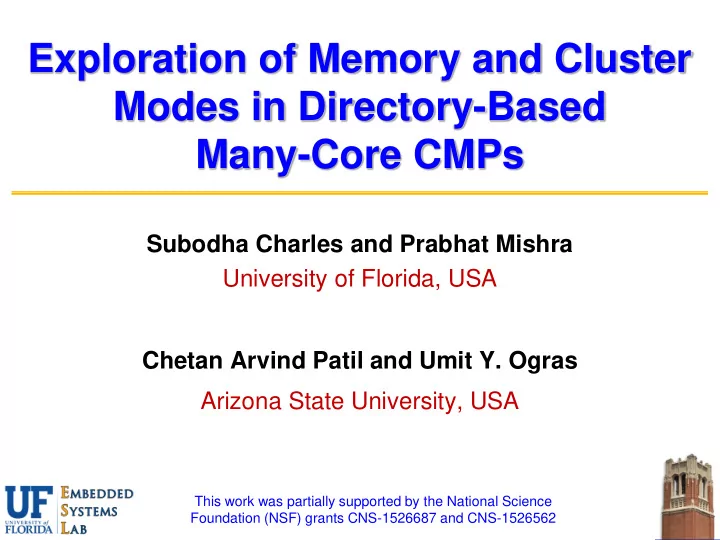

Exploration of Memory and Cluster Modes in Directory-Based Many-Core CMPs Subodha Charles and Prabhat Mishra University of Florida, USA Chetan Arvind Patil and Umit Y. Ogras Arizona State University, USA This work was partially supported by the National Science Foundation (NSF) grants CNS-1526687 and CNS-1526562
Outline Introduction Existing NoC Exploration Methods Accurate Modeling and Exploration ❖ Motivation ❖ Modeling of Directory – Memory Traffic ❖ Exploration of Memory and Cluster Modes Experimental Results Conclusion 2
Increased Complexity of SoC Design
Increased Complexity of SoC Design
NoCs are Ciritcal for Performance Does Not Scale! Early interconnection designs were buses and point-to-point Solution: NoC
Architecture of a Many-Core CMP
Outline Introduction Existing NoC Exploration Methods Accurate Modeling and Exploration ❖ Motivation ❖ Modeling of Directory – Memory Traffic ❖ Exploration of Memory and Cluster Modes Experimental Results Conclusion 7
Traffic Optimization on NoC Optimum MC Min # of MCs Placement Eitschberger et al. Xu et al. MCC ‘13 CODES+ISSS ‘13 Dynamic Workload Data Mapping Awasthi et al. PACT ‘10 8
Optimum MC Placement Column 0/7 Column 2/5 Diamond Xu et al. Optimum Slash CODES+ISSS ‘13 9
Outline Introduction Existing NoC Exploration Methods Accurate Modeling and Exploration ❖ Motivation ❖ Modeling of Directory – Memory Traffic ❖ Exploration of Memory and Cluster Modes Experimental Results Conclusion 10
KNL: 2 nd Generation Xeon-Phi 38 tiles 36 active, 2 recovery Each tile; 2 VPUs, Out of order 4 threads per core 4 separate NoCs
Traffic Model of gem5 Simulator Life Cycle of a memory request: (1) Request forwarded 1 to Directory Controller after miss 3 in private cache 2 (2) Data retrieved from memory (3) MC forwards data to the requestor
A Memory Controller at Each Tile? Is this a realistic assumption??? Number of MCs < Number of tiles Packaging constraints High I/O pin cost
Intel Xeon-Phi 7210
Hotspots Introduced by MCs
Key Idea The interactions between cores, directory controllers and memory controllers should be accurately modelled to enable exploration of NoC optimization
Outline Introduction Existing NoC Exploration Methods Accurate Modeling and Exploration ❖ Motivation ❖ Modeling of Directory – Memory Traffic ❖ Exploration of Memory and Cluster Modes Experimental Results Conclusion 17
Modified Traffic Model Life Cycle of a memory request: (1) Request forwarded 1 to Directory Controller after miss in private cache 2 (2) Forward request to 4 MC. 3 (3) Data retrieved from memory (4) MC forwards data to the requestor
Modified Traffic Model The inclusion of the new step (2) has a significant impact Introduces hotspots Realistic estimate of power and performance data. Exploration of MC placement. Exploration of Cluster and Memory modes 19
Modified Traffic Model
Outline Introduction Existing NoC Exploration Methods Accurate Modeling and Exploration ❖ Motivation ❖ Modeling of Directory – Memory Traffic ❖ Exploration of Memory and Cluster Modes Experimental Results Conclusion 21
Cluster Modes in KNL 2 3 3 2 1 1 Quadrant Mode All-to-all Mode Four virtual quadrants. A request A request from a core can be from a core can be forwarded to any forwarded to any directory directory controller. But the memory controller. The memory request should be sent to an MC on request can be forwarded to the same quadrant as the directory. any MC as well.
Memory Modes in KNL 3 4 2 1 1 3 2 Flat Mode Cache Mode DDR and MCDRAM in the MCDRAM acting as same address space last-level cache
Traffic Flow – Memory and Cluster Modes Cache, All-to-all Flat, All-to-all Mode Mode Flat, Quadrant Mode
Outline Introduction Existing NoC Exploration Methods Accurate Modeling and Exploration ❖ Motivation ❖ Modeling of Directory – Memory Traffic ❖ Exploration of Memory and Cluster Modes Experimental Results Conclusion 25
Experimental Setup Architecture Simulator: gem5 NoC model: Garnet2.0 A CMP similar to Xeon-Phi 7210 modeled in gem5 Our implementation added in the cache coherence traffic transitions. Gem5 output statistics fed into McPAT simulator to extract power results.
Network Traffic Analysis The default gem5 model gives highly optimistic results The two modified models – KNL (all-to- all) and KNL (quadrant) gives comparable results KNL (quadrant) gives better performance as it has high affinity between directory and memory controllers.
Memory Controller Placement Exploration of memory controller placement under the modified model. Compared with the work done by Xu et al. “Optimal” is no longer the optimal placement. The default gem5 model again gives highly optimistic results
Memory and Cluster Mode Exploration Compared to All-to-all Flat mode, All-to-all Cache mode gives highest benefit : 18.62% less execution time on average Observations are in agreement with results obtained from Xeon Phi 7210 hardware platform
Conclusion 30
Thank you! Questions?
Recommend
More recommend